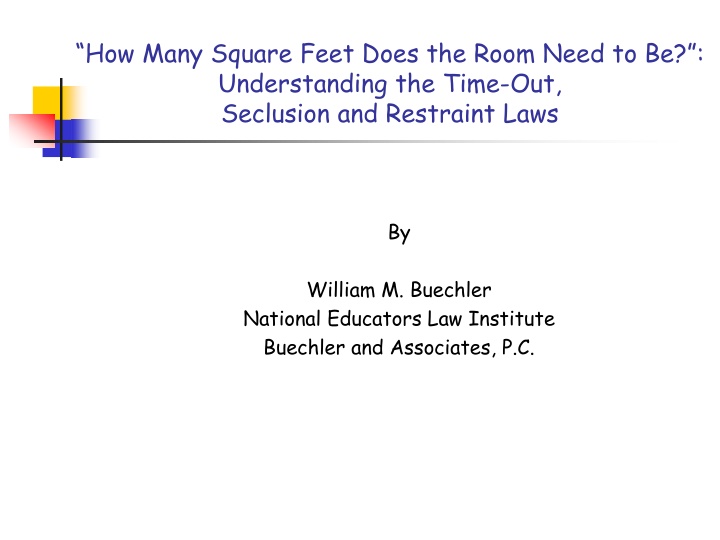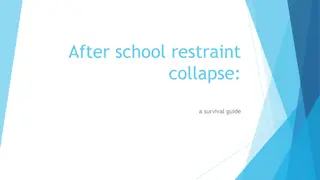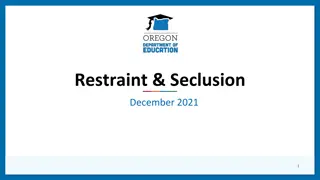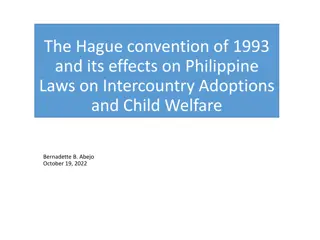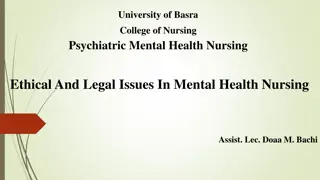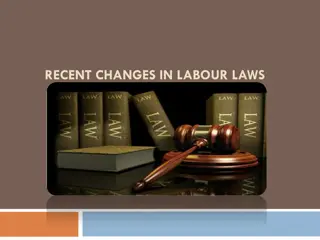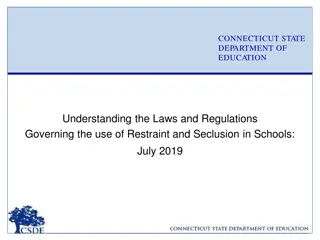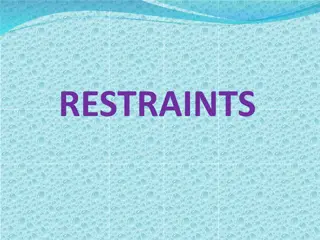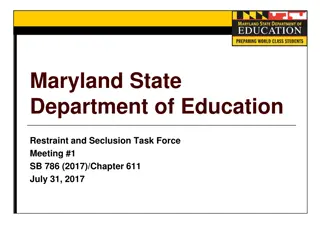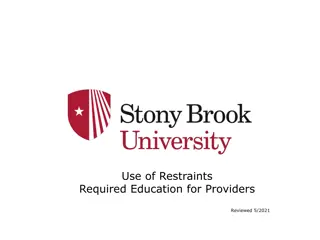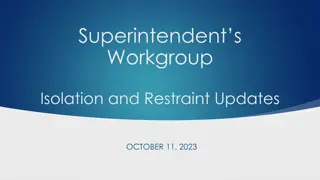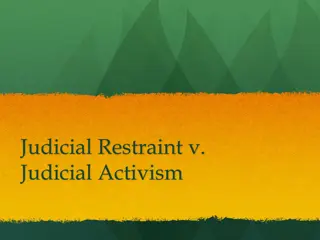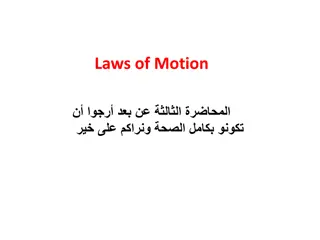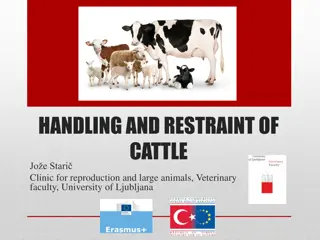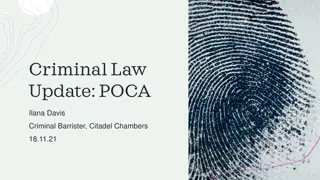Laws and Guidelines on Time-Out, Seclusion, and Restraint in Education
Overview of the statutory and regulatory references in Texas relating to the use of time-out, seclusion, and restraints for students exhibiting certain behavioral characteristics. It includes details on the use of restraints, considerations for special needs students, and procedural requirements to follow when implementing restraints.
Download Presentation

Please find below an Image/Link to download the presentation.
The content on the website is provided AS IS for your information and personal use only. It may not be sold, licensed, or shared on other websites without obtaining consent from the author.If you encounter any issues during the download, it is possible that the publisher has removed the file from their server.
You are allowed to download the files provided on this website for personal or commercial use, subject to the condition that they are used lawfully. All files are the property of their respective owners.
The content on the website is provided AS IS for your information and personal use only. It may not be sold, licensed, or shared on other websites without obtaining consent from the author.
E N D
Presentation Transcript
How Many Square Feet Does the Room Need to Be?: Understanding the Time-Out, Seclusion and Restraint Laws By William M. Buechler National Educators Law Institute Buechler and Associates, P.C.
STATUTORY AND REGULATORY REFERENCES Texas Education Code Section 37.0021 Texas Administrative Code Section 89.1053
COMMON BEHAVIORAL CHARACTERISTICS WHERE TIME-OUT, SECLUSION AND RESTRAINTS MAY COME INTO PLAY From a behavioral perspective, some common behaviors that students may engage in include: Aggression towards others Self-injurious behavior Off-task behavior Refusal to follow directives or instructions Taking property of others Leaving assigned areas without permission
USE OF RESTRAINTS Texas law applies to special education students. Restraint means the use of physical force or a mechanical device to significantly restrict the free movement of all or a portion of a student s body. Restraint can be used when the child s behavior poses a threat of imminent and serious physical harm to the child or others, or property destruction.
RESTRAINTS CONT The use of restraint must: Be limited to such force as is reasonable to address the emergency Be discontinued when an emergency no longer exists Be mindful of the newly enacted requirements in Section 37.0023 regarding the use of aversive techniques .
SPECIAL NEEDS STUDENTS AND ELOPEMENT Limited physical contact with the child to promote safety, prevent a potentially harmful action, teach a skill, or to provide comfort does not constitute a restraint. Likewise, seat belts and other safety equipment used to secure children during transportation are not considered restraints.
RESTRAINT PROCEDURAL ISSUES Good faith effort to notify parents verbally on day restraint used Written notification placed in mail or otherwise provided within one school day of the use of restraint Written notice must state date and length of restraint Notice must provide a description of the activity the child was engaged in immediately before the restraint, and the behavior that prompted the restraint The notice must also describe the efforts made to de-escalate the situation and alternatives to restraint that were attempted
TRAINING AND POLICE OFFICER USE OF RESTRAINT A core team of personnel must be trained, including a campus administrator or designee and any general or special education personnel likely to use restraint. The training must include instruction in current professionally accepted practices and standards regarding behavior management and the use of restraint. Restraint laws apply to peace officers employed or commissioned by the district or who provide a police presence as a resource officer through an MOU.
USE OF TIME-OUT Used for a student to regain self-control The student is separated from other students for a limited period in a setting that is not locked and from which the exit is not physically blocked by furniture, a closed door held shut from the outside, or another inanimate object The room must be at least 50 square feet
SECLUSION DEFINED Seclusion means a behavior management technique in which a student is confined in a locked box, locked closet, or locked room that: Is designed solely to seclude a person; and Contains less than 50 square feet of space. a. b.
SECLUSION EXCEPTION The law does not prevent a student s locked, unattended confinement in an emergency situation while awaiting the arrival of law enforcement personnel if: The student possesses a weapon; and The confinement is necessary to prevent the student from causing bodily harm to the student or another person. 1. 2.
DEFINITION OF WEAPON For purposes of the seclusion law, a weapon includes any weapon described under Section 37.007(a)(1) of the Texas Education Code relating to expulsions. Thus, any explosive weapons or devices are included, such as assault rifles, handguns, machine guns, other firearms, and explosive devices.
SPRING BRANCH ISD v. O.W. (5thCir. 2019) Recent Fifth Circuit case addressing time-out and restraint in special education. FACTS: O.W. was in fifth grade and eventually was determined to qualify as ED. When he engaged in inappropriate behavior, the student was directed to a desk in the classroom for 5 or 10 minute intervals. During those times, the student could engage in replacement behaviors, such as drawing. The student was placed in the desk for the 5 or 10 minute intervals during 16 of his 40 days on the campus.
SPRING BRANCH ISD v. O.W. (5thCir. 2019) ADDITIONAL FACTS AND ARGUMENTS: Texas law allows time-outs in conjunction with positive behavioral supports. The parties agreed that time-out was not included as part of the student s IEP or BIP. The parties also agreed that the methods were used on a recurrent basis. The district argued that the methods were not time-outs since the desk was in the classroom, the student was not separated from the other students, and he was given an opportunity to do preferred activities.
SPRING BRANCH ISD v. O.W. (5thCir. 2019) COURT S DETERMINATIONS REGARDING TIME-OUT: If utilized on a recurring basis under Texas law, time-out must be included in the IEP or BIP. The court focused on the student s separation from the other students, even for a limited period of time. The court determined that is was irrelevant whether the time-out was in the same classroom or the student could pursue preferred activities. An IEP or BIP which does not authorize the recurrent use of time outs effectively prohibits such use.
SPRING BRANCH ISD v. O.W. (5thCir. 2019) COURT S DETERMINATIONS REGARDING THE USE OF RESTRAINTS: During his time at the campus, O.W. was restrained a total of 8 times. The court determined that under Texas law, physical restraints are specifically authorized only in emergency situations. The court further stated that [u]nlike the use of time-outs, the law contains no provision requiring that the use of physical restraints be expressly authorized by a student s IEP.
BIPS AND THE STUDENT CODE OF CONDUCT The BIP supplements the SCOC, unless the student is incapable of intent. The strategies in the BIP need not be followed in sequential order. The behavior dictates the strategies. The BIP is intended to shape positive behaviors. Every potential consequence does not need to be listed in the BIP. If used on a recurrent basis, time-out must be included in the IEP or BIP. Since they can only be used in emergency situations, the use of restraints does not need to be expressly provided for in the IEP.
FBAs AND GATHERING BEHAVIORAL DATA Problem behaviors serve a purpose Students will repeat behaviors that work for them When gathering behavioral data, consider interviews with staff, parents, and students Analyze written data such as point sheets and problem solving sheets Gather data through direct observations that includes frequency counts and duration
